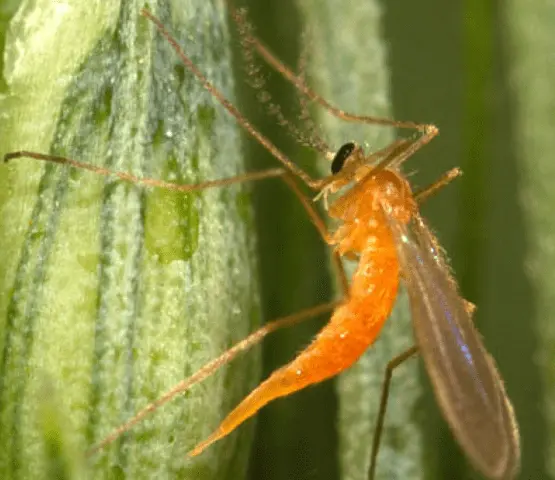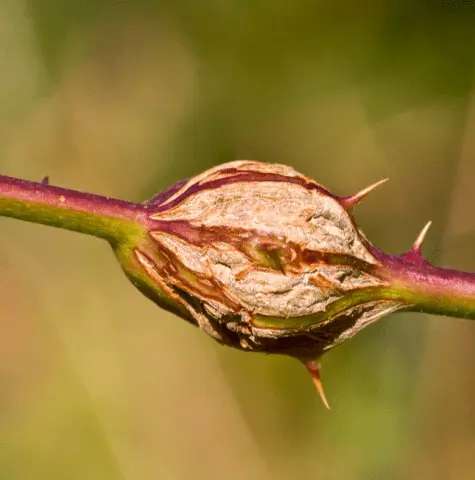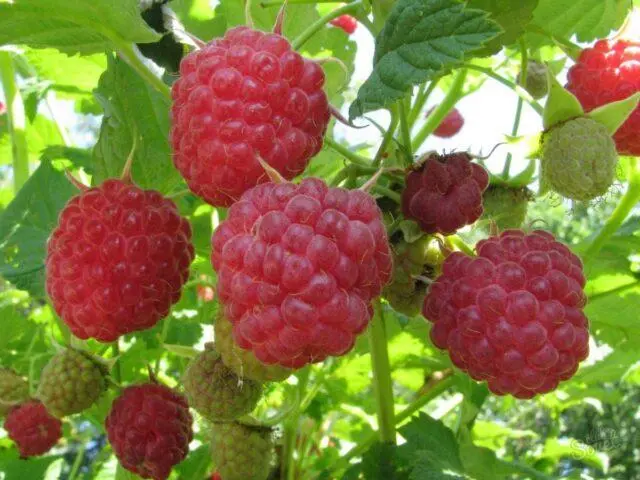Contents
The stem gall midge on raspberries is a dangerous pest that can lead not only to the loss of 80% of the crop, but also to the death of the raspberry. In appearance, the adult insect resembles a bright orange mosquito. To combat it, folk remedies, as well as chemicals are used. If the invasion is strong, it will be necessary to carry out three treatments per season.
What is a gall midge
Gall midge (Cecidomyidae) is an insect from the Diptera order. It is a dangerous pest that infects raspberries and many berry crops, as well as fruit, cereals, legumes and ornamental plants. In total, there are almost three thousand species in the family of gall midges, with two of the most common:
- Runaway.
- Stem.
They can be found in all regions of the world, including in different regions of Our Country.
Appearance
Adult gall midges resemble small mosquitoes. The body is not more than 2 mm in length, the color of the abdomen is orange-red, the wings are transparent. The larvae are of the same color, but they are larger – they reach 3-4 mm in length. They hibernate in the surface layer of soil (depth up to 3 cm) under raspberry bushes, as well as at the base of the shoots.
In May, they turn into pupae, then young insects appear from them (adult stage). They mate, females lay their eggs in cracks, damage to the bark of raspberries, at the bases of leaf petioles (mainly in young shoots). Then, orange-colored gall midge larvae reappear from the eggs. They unite in colonies (up to 200 individuals in each).

An adult insect is easily identified by its bright coloration.
What harm does
Raspberries and other crops are harmed by two generations of gall midge larvae. The first appears in June, and is the most dangerous. The second generation is distributed in July. The larvae do not gnaw through raspberry tissue because they have a small head and no piercing parts. Instead, pests secrete special substances that lead to rapid cell division and the formation of a dense rounded formation – a gall. This is what gall midges eat.
It is quite simple to determine the invasion of the stem gall midge on raspberries – the body of the insect is orange, as shown in the photo. There are also other signs of its appearance:
- formation of ridges on the surface of the bark;
- the occurrence of sagging, thickening;
- wilting and drying of the stems.
Gall midge is a dangerous pest of raspberries. The appearance of an insect leads to negative consequences:
- 10-15% of affected shoots die in winter due to frost.
- In the second year, affected raspberry shoots produce leaves with a significant delay.
- More than half (up to 70% of the kidneys) may not bloom.
- The stems break, especially under the weight of snow and gusts of wind.
If action is not taken, 30% to 80% of all raspberry shoots can suffer, especially young growth. This naturally leads to a reduction in yield by 5-6 times. Sometimes it is not possible to collect even 1 kg of berries from a raspberry bush for the whole season.
Visually, raspberry disease can be determined by the formation of purple spots on the surface of the bark. In this case, it is necessary to carry out treatment not only with insecticides, but also with powerful fungicides.
Reasons for infection
Since the gall midge is ubiquitous, it is not possible to completely avoid the defeat of raspberries. There are several factors that provoke an insect invasion:
- cracks and other damage, especially on young shoots;
- excessive amounts of fertilizer, which can also lead to cracking of the bark;
- too frosty November and December combined with early warm spring;
- planting raspberries in the lowlands, where stagnant water is observed, as well as the runoff of cold air masses.

The shoot affected by the pest can be identified visually
Measures to combat raspberry gall midge
To combat the stem raspberry gall midge, different methods are used. The most effective chemicals. But if the raspberries are already bearing fruit, and the harvest is ripening, it is better to use folk remedies. Also, do not forget about the preventive treatments of shrubs, which are carried out in the middle of spring.
Chemical preparations for raspberry gall midge
Chemical insecticides help fight not only crimson gall midge, but also other pests. As a rule, it is enough to carry out only two treatments to achieve the desired result. Among the effective preparations for raspberries are the following:
- “Karate”.
- “Fufanon”.
- “Spark”.
- “Karbofos”.
- “BI-58”.
Means are used strictly according to the instructions, since many drugs are toxic to humans, animals and beneficial insects. The solution must be prepared in quantities that can actually be used in one treatment – it cannot be drained into the general sewer.
Folk remedies
Folk remedies show their effectiveness in the early stages of the invasion. It is also possible to treat raspberries, on which stem gall midge has appeared, at the fruiting stage, when there are several days left before harvesting. Most summer residents use the following recipes:
- Processing with dandelion infusion. After weeding, the grass is sorted (together with the root), crushed with a shovel. Take 2 kg of raw materials and pour 10 liters of water at room temperature. Insist from 2 to 12 hours, then filter and bring to a total volume of 10 liters. Processing of raspberries from gall midges should be done every 2-3 days until the pest is completely destroyed.
- You can also get rid of gall midges on raspberries using an aqueous emulsion of kerosene – 100 ml per 10 liters. Processing is carried out at the end of May and again – in mid-June. For raspberries, 2-3 sprays are enough.
- Crush the cloves and fresh greens of garlic, take 500 g of raw materials and pour a bucket of water at room temperature. Insist for a day, filter and process raspberries several times with an interval of 2-3 days.
- You can also take onions along with the husk, chop 1 kg of raw materials and pour 10 liters of warm water (but it should not be hot). Leave for 3 hours and add half a bar of grated laundry soap. After that, mix thoroughly, strain and proceed to the processing of raspberry bushes.

Spring spraying should be carried out after sanitary pruning
In this case, processing must be done no later than the end of April, since already in May the larvae become active.
Prevention
It is quite possible to prevent the appearance and active reproduction of gall midges on raspberries. There are several proven ways to do this:
- When landing, choose well-lit places. They should not be located in the lowlands.
- Cut off any damaged branches promptly. It is on shoots with cracked bark that gall midges often settle. They are pruned in early spring, before active sap flow begins.
- Do not give too much fertilizer – it is better to underfeed a little than overfeed. If the soil is fertile, it is enough to fertilize twice – in early spring and at the stage of bud formation.
- In April, it is recommended to carry out preventive treatment of raspberries with insecticides. Especially carefully should be sprayed damaged shoots. At this point, even chemical agents can be used, since about two more months will pass before fruiting begins.
- If there was previously a lesion with gall midge, in the spring the top layer of soil up to 3 cm deep is removed.
- Periodically, you should loosen the soil and at the same time do weeding.
- In autumn, it is necessary to lay mulch from chopped tops of tomatoes or potatoes. Raspberry leaves, on the contrary, are carried as far as possible.
- In the autumn, inspect the bushes again and remove damaged raspberry shoots with cracked bark.
When planning new plantings, it is recommended to choose those raspberry varieties that have satisfactory or high resistance to gall midge. These include: Pride of Our Country, Zorenka Altai, Ruby Seedling, Vera, Bell, Arched.

Raspberry Vera is one of the varieties with high resistance to gall midge
You should also pay attention to varieties that are less prone to cracking of the bark than others: Torch, Vera, Credo, Sokolenok, Ruby, Brilliant, For Health, Troyana.
The gall midge most strongly affects such varieties of raspberries: Barnaulskaya, Zorenka, Ogonyok, Daughter of Vislukha.
Conclusion
The stem gall midge on raspberries is quite dangerous. The insect multiplies rapidly and can infect not only raspberries, but also bushes of other plants. Therefore, it is necessary to fight at an early stage. If the invasion is strong, and even chemical agents do not help, it is easier to destroy the raspberries, disinfect the soil, and then plant new varieties that are resistant to gall midge.









